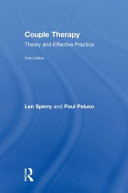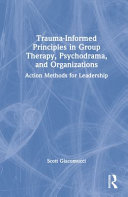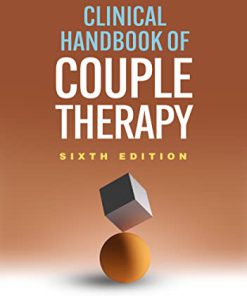Routine outcome monitoring in couple and family therapy The empirically informed therapist 1st Edition by Terje Tilden, Bruce Wampold 3319506749 9783319506746
$50.00 Original price was: $50.00.$25.00Current price is: $25.00.
Routine outcome monitoring in couple and family therapy The empirically informed therapist 1st Edition by Terje Tilden, Bruce Wampold – Ebook PDF Instant Download/Delivery: 3319506749, 9783319506746
Full download Routine outcome monitoring in couple and family therapy The empirically informed therapist 1st Edition after payment

Product details:
ISBN 10: 3319506749
ISBN 13: 9783319506746
Author: Terje Tilden, Bruce E. Wampold
This research-to-practice manual introduces Routine Outcome Monitoring (ROM), a feedback-based approach to preventing impasses and relapses in couple and family therapy as well as within other psychotherapy approaches. This book discusses how ROM has been developed and experienced within the Norwegian couples and family therapy community in line with international trends of bridging the gap between clinical practice and research. Locating the method in evidence-based systemic practice, contributors describe the core techniques, tools, and process of ROM, including examples of effective uses of feedback over different stages of therapy, with individuals in family context, and implemented in different countries. Giving clients this level of control in treatment reinforces the concept of therapy as a collaborative process, fostering client engagement and involvement, commitment to treatment, and post-treatment progress. ROM is applicable across clinical settings and clinician orientations for maximum utility in work with clients, and in building therapeutic self-awareness. Features of the book: •Theoretical and empirical context for using ROM with families and couples. •Tools and procedures, including the Systemic Therapy Inventory of Change. •Guidelines for treatment planning, implementation, and evaluation. •Common challenges in using ROM with couples and families. •Supervisory, training, and ethical issues. •Examples and vignettes showing ROM in action. With its deep potential for promoting client progress as well as therapist development, Routine Outcome Monitoring in Couple and Family Therapy: The Empirically Informed Therapist will attract practitioners and research professionals particularly interested in clinical practice, client-directed methods, and couple or family therapy.
Routine outcome monitoring in couple and family therapy The empirically informed therapist 1st Table of contents:
1 How Do I Know Whether My Efforts Are Helpful for the Client? Implementing Feedback in Norway
Introduction
Our Mission and Challenge
The Professional Development of Systemic Practices
Evidence-Based Practice and Levels of Evidence
The Governmental Guidelines
The Characteristics of Feedback
The Implementation and Dissemination of ROM in Norway
Practice-oriented Research
The Pros and Cons of ROM
The Pros
The Cons
Concluding Section
References
Couple and Family Therapy in Norway
2 The History of Family Therapy in Norway
What Paved the Ground for the Development of Family Therapy in Norway?
Overarching Themes—Trends and Headlines Seen as Historical Processes
Family Therapy in Norway Through the Decades
Family Therapy in the 1960s and 1970s
The 1980s
The 1990s
After 2000
The Important Working Contexts for Family Therapists
Family Counseling Services
Child and Adolescent Psychiatry
Adult Psychiatry
Modum Bad
History
The Treatment
Evaluation and Research
Diagnostic Challenges
International Contacts and Inspirations
The Research Institute
Publishing About Family Therapy
Norsk Forening for Familieterapi (NFFT)
Family and Family Therapy Research in Norway
Research Concerning Family Therapy with Children and Adolescents
Educating Family Therapists
Family Therapy in Norway—Is There a Future?
References
3 A Sociological Perspective on Changes in the Family in Norway
Introduction
Background Information on Norway
A Snapshot of Contemporary Norwegian Families
“Liquid” Relationships
The Gendered Division of Labor, Homemaking, and Money
“New” Fatherhood and Motherhood: Intensive Parenting
Family Changes and Couple/Family Therapy
Concluding Remarks
References
4 Family Therapy and Philosophy: Inspiration and Frustration
Introduction
My Journey to Family Therapy and Norway’s Family Counseling Service
Family Therapy Education: Constructivism and Anti-psychiatry
Change and Second-Order Cybernetics
Constructivism + The Legacy of Descartes = Epistemological Skepticism?
The Therapy Room as a Space of Freedom
The Profession’s Three Philosophical Pillars
A Paradox
Fiction Versus Reality
Constructivism + Social Constructionism = Relativism
Pragmatism and Evidence-Based Practice
Language and the World: There Is also a Correspondence Theory
First Preliminary Summary
The Problematic “Not-Knowing” Position
Both Therapy and Counseling?
Socratic Approach: The Midwife Method
Kierkegaard and the Art of Helping
The Not-Knowing Position and Solipsism: No Man Is an Island
Second Preliminary Summary
The Informed Versus the Not-Knowing Therapist
Proximity Ethics and Second-Order Cybernetics Go Hand in Glove
Proximity Ethics Challenge: An Inadequate Therapist
Courtesy, Respect, and Sound Methods May Be Enough
Conclusion
References
Practice-Oriented Research and Routine Outcome Monitoring
5 The Systemic Therapy Inventory of Change—STIC: A Multi-systemic and Multi-dimensional System to
The STIC System
The STIC Initial
The STIC Intersession
The STIC Online Data Collection and Feedback System
An Evolving Measurement and Feedback System
The STIC as a Research Tool
The STIC as a Clinical Tool
The Collaborative Use of the STIC
Collaborative, Empirically Informed Assessment
The Big Six and the Big Three
Individual Versus Couple Versus Family: Whom to See?
Creating an Empirically Informed Problem Narrative
Creating an Empirically Informed Intervention Plan—What to Address When?
Empirically Informed Progress Evaluation
Collaborative, Empirically Informed Termination Assessment/Planning
Empirically Informed Multi-systemic Therapy
The Clinical-Research Loop
The STIC System as a Comprehensive Clinical and Research Tool
References
6 The Norwegian Directorate for Children, Youth and Family Affairs’ Efforts to Implement Feedback
Introduction
Evidence-Based Practice in FCS
“The Norwegian Study”
Decision to Implement KOR in All FCS Offices
PCOMS, the Measures ORS and SRS, and the Norwegian Term KOR
Clinical Cutoff of the ORS
Electronic Systems for Administering and Scoring the KOR Measures
The Validation of ORS and SRS
Implementation
Implementing KOR in the FCS: Model and Pilot Project
Pilot FCS Offices
The Role of the Coordinator
Skill-Building Conferences
Consultation
The Four Phases of the Implementation from 2009 to 2012
KOR Supervision
Implementing an Electronic System
Positive Experiences
Objections from the Clinicians
Problems and Challenges that Occurred in the Implementation Process
The Importance of Adequate KOR Introduction
Clinical Autonomy Versus User Involvement
Looking into the Mirror of Implementation Research
Lessons Learned
References
7 Feedback as Means to Enhance Client–Therapist Interaction in Therapy
Introduction
A Very Short History of the Introduction of Routine Outcome Monitoring and Service User Feedback in
Client-Directed, Outcome-Informed Therapy in a Family Therapy Context
The Outcome Rating Scale and The Session Rating Scale as Conversational Tools
The CD of the CDOI—The Question of Service User Participation
The OI of the CDOI—The Question of Being Informed by Data
What Could Be New in Client–Therapist Interactions as a Result of Feedback?
To Follow the Client and Be Challenged by Data
Closing Remarks
References
8 Does Feedback Enhance User Involvement in Therapy?
Introduction
User Involvement Through Structured Feedback
The Systemic Therapy Inventory of Change (STIC) Feedback Procedure
Three Ways of Making Meaning from a Feedback Questionnaire Procedure
The Study
Expectations About the Use of STIC
Experiences with the Use of STIC
Feedback Procedures Give the Opportunity to Ask Difficult Questions
Feedback Procedures Give the Opportunity to Explore Multiple Meanings
Feedback Procedures Give the Opportunity to Share Information with Everyone in the Room
Conclusion
References
9 Empirically Informed Therapy Conducted at the Family Unit, Modum Bad
Introduction
The Modum Bad Context
Theoretical and Empirical Background
The CFT Treatment Approach
The Use of ROM at the Family Unit
Treatment-Planning and Building Alliances
Collaborative Approach to Therapy Enhances Change
Addressing Lack of Changes and Alliance Ruptures
Clinical Judgement
Closing Remarks
References
10 Family Therapy and Holistic Complexity—An Ethnographic Approach to Therapeutic Practice in a No
Introduction
Our Ethnographic Approach
Dilemmas of Symmetrical Reciprocity
Autonomy and Boundaries
A Therapeutic Agora
Perspectivism
Contextual Complexity in Therapy
Summing Up
References
11 An Anthill of Questions that Made Me Prepare for the First Session: A Clinical Vignette of the Us
Introduction
Our Context
Our Theoretical Platform and the STIC Procedures
Answering Before Meeting the Therapist in Person
Too Burdensome for a Family in Crisis?
To Become Visible
Forced to Be Clearer
To Be Exposed
Does STIC Open Up for Untold Stories?
Changes Displayed and not Displayed on the STIC Graphs
STIC Works Outside the Therapy Room
Youth, Truth, and STIC
Is STIC in the Way?
One Size Fits All?
Alliance
Conclusion
References
12 Lessons Learned from the Implementation of a Feedback System in Couple and Family Therapy
Introduction
Background
Implementation
Studies on ROM Implementation
Lessons Learned from Our Project
The Honeymoon Phase
From Initial to Action Phase
The Downturn Phase
The Upturn Phase
The Consolidation Phase
Implications
Conclusion
Acknowledgements
References
Reflections from Abroad on Couple and Family Therapy in Norway
13 How, When, and Why Do People Change Through Psychological Interventions?—Patient-Focused Psycho
Introduction
Dose–Response and Phase Models of Therapeutic Change
Decision Support Rules
Rationally Derived Methods
Empirically Derived Methods
Nearest Neighbors Techniques
Detecting Typical Patterns of Patient Change
Rationally or Empirically Derived Decision Rules
Mediators and Moderators of Psychometric Feedback Effects
Therapist and Patient Differences
How Does Feedback Work?
Summary
References
14 How to Use Research to Become More Effective Therapists
The Contextual Model
Initial Therapeutic Bond
The Real Relationship
Creation of Expectation Through Explanation and Treatment
Enacting Health Promoting Actions
The Three Pathways in Summary
Actions of Effective Therapists
Alliance
Facilitative Interpersonal Skills
Delivery of a Cogent Treatment
Professional Self-doubt and Deliberate Practice
Characteristics and Actions of Therapists that Are not Related to Outcome
Conclusions
References
15 How Can Outcome Data Inform Change? Experiences from the Child Mental Health Context in Great Bri
Introduction
Use of Outcome Data in Direct Clinical Work (Decision Making in Relation to Individual Children and
Which Measures to Choose?
How to Use Measures Clinically and Meaningfully
Decision Making for Service Development
Time and Resources Involved
Data Quality, Reporting and Using Information from Measures
Research
Summary
References
Concluding Remarks
16 Epilogue
Changed, but Still the Same?
CFT Part of the Psychotherapy Family?
Evidence-Based Practice
One Size Fits All?
ROM/POR
Where Are We Heading?
People also search for Routine outcome monitoring in couple and family therapy The empirically informed therapist 1st:
routine outcome monitoring
couple therapy questionnaire
routine outcome measurement in therapy
routine outcome monitoring depression
Tags:
Terje Tilden,Bruce Wampold,Routine,monitoring
You may also like…
Psychology - Psychotherapy
Psychology - Psychotherapy
Relationships & Lifestyle - Sexuality
Couple Therapy Theory and Effective Practice 3rd Edition Len Sperry Paul R Peluso
Psychology - Psychotherapy
Psychology - Psychotherapy
Multi generational Family Therapy Tools and resources for the therapist Maurizio Andolfi
Psychology - Psychotherapy
Relationships & Lifestyle - Relationships
Clinical Handbook of Couple Therapy 6th Edition Jay L. Lebow











